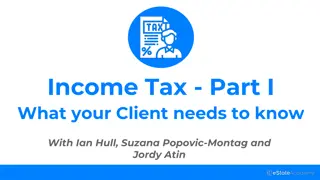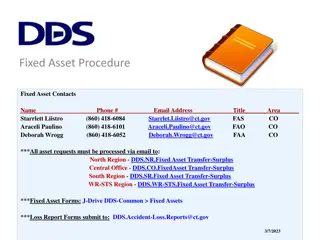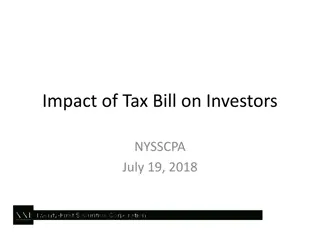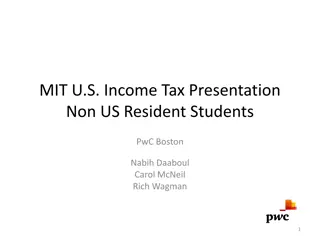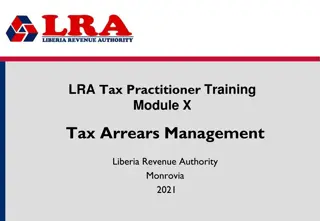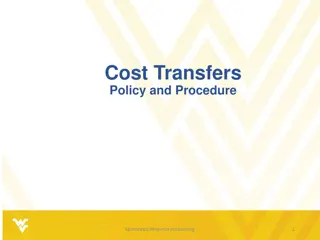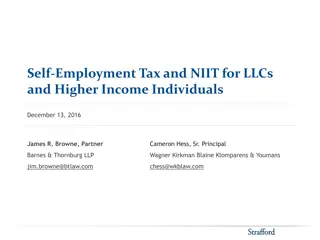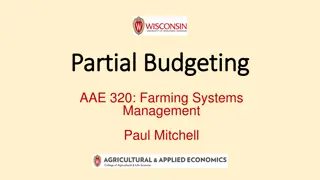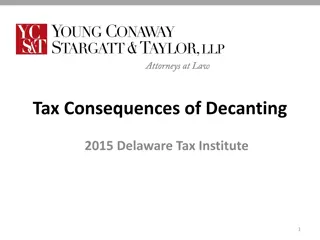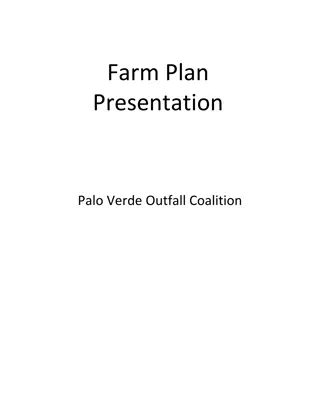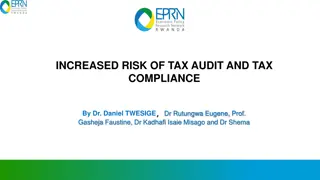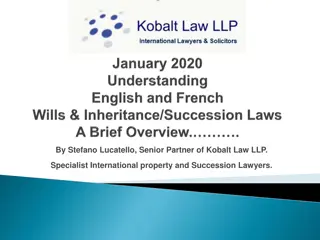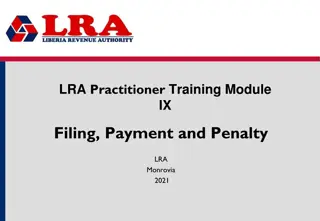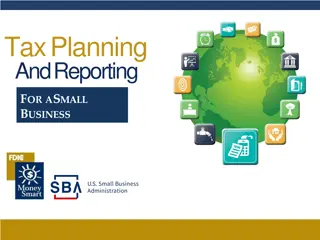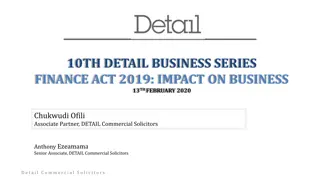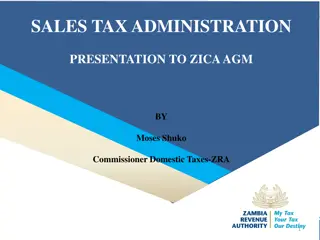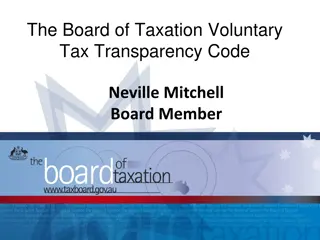Tax Considerations for Farm Asset Transfers
Understand the tax implications of transferring farm assets based on different methods such as sale, gift, transfer at death, trade, or transferring to a business entity. Learn about the various taxes farmers pay, including property, sales, employment, income, self-employment, gift, and death taxes. Explore examples of tax consequences for sales of land, cows, and machinery, including gains and basis calculations, as well as the character of gains affecting tax rates.
Download Presentation

Please find below an Image/Link to download the presentation.
The content on the website is provided AS IS for your information and personal use only. It may not be sold, licensed, or shared on other websites without obtaining consent from the author. Download presentation by click this link. If you encounter any issues during the download, it is possible that the publisher has removed the file from their server.
E N D
Presentation Transcript
Tax Considerations of Farm Transfers Based on the work of Philip E. Harris Center for Dairy Profitability Professor and Extension State Specialist in Agricultural and Applied Economics University of Wisconsin-Madison AAE 320 Paul D. Mitchell Agricultural & Applied Economics
Learning Goal To understand the options for transferring farm assets from one generation to the next and the tax consequences of each option Most of these options and rules also apply to non-farm assets
Alternatives for Transferring Farm Assets 1. Sale 2. Gift 3. Transfer at death 4. Trade 5. Transfer to a business entity
Taxes paid by Farmers Property (real estate) taxes Sales taxes Employment taxes Income taxes Self-employment taxes Gift taxes Death (estate) taxes Our focus in AAE 320
#1: Sale (p. 1) Seller has no gift or death tax consequences Seller likely has income tax and self-employment tax consequences Depends on the amount of this Gain (or loss) and the Character of this Gain Gain = Amount seller recognizes from sale minus seller s tax basis in the asset Typically means Gain = Sale Price Tax Basis
Example 1: Land (p. 1) Sale Price Basis Gain $295,000 $11,800 $283,200 Original purchase price Basis for land is the original purchase price
Example 2: Cows (p. 1-2) Sale price of cows $130,000 Income tax basis Gain $130,000 $0 No basis in raised farm assets, owner gets to deduct annual costs of raising them each year
Example 3: Machinery (p. 2) Sale price Basis Gain $58,934 $8,434 $50,500 Basis is the value remaining after tax depreciation deductions taken
Character of Gain (or Loss) Different types of gains are subject to different types of taxes This is called the Character of the Gain Three types of taxes to consider Ordinary income (10% - 37%) Capital gain (0% - 20%) Self-employment income (15.3%)
Self-Employment Tax Example 4 (p. 2-3) Normally employer & employee split this tax, but if self- employed, must pay both halves Mix of Social Security and Medicare taxes Social Security tax is 12.4% of first $128,400 of self employment income earned in 2018 The max earnings amount is inflation indexed: $132,900 in 2020 Medicare: 2.9% of self employment income, with more if income above certain levels 12.4% + 2.9% = 15.3%
Three Categories of Gain (p. 3) i. Subject to ordinary income tax and to self- employment (SE) tax Subject to ordinary income tax, but not to SE tax Capital gain or ordinary loss ii. iii.
i. Subject to ordinary tax rates and to SE tax Gain from sale of assets held for sale in the ordinary course of business Most common: Grain, feeder livestock, milk Generally sale of current assets Gain from calves is subject to ordinary income tax and SE tax Gain from sale of heifers & cows does not fall into this category
ii. Subject to ordinary income tax, but not SE tax Common examples: Sale of specific types of non-current assets Depreciation Recapture Example 6, p. 3 Avoid SE tax (15.3%) on gain when resell machinery if use Section 179 to deduct full cost of machinery as depreciation when purchased Gain from sale of young breeding stock Example 7 (p. 3-4) Young is defined in tax law: a 12-24 month holding period required
iii. Capital gain or ordinary loss Capital gain tax rates less than income tax rates: (incentive to invest) Assets like land, buildings, breeding livestock Generally most non-current assets, except those in 2nd category Short-term gains for assets held less than 1 year are treated as ordinary income Example 8 (p. 4) Capital Gains tax rate depends on your taxable income >$441,450 Taxable Income (single) Taxable Income (married filing joint) Cap Gains Rate < $40,000 < $80,000 0% 15% $40,001 to $441,450 $80,001 to $496,600 >$496,600 20%
iii. Capital gain or ordinary loss In 2013: Net Investment Income Tax (NIIT) of 3.8% was imposed on investment income if your AGI > $200,000 ($250,000 MFJ) Farm assets are not subject to the tax, but a land sale can push your AGI above the limit so that other investment income becomes subject to this tax (Example 9, p. 4-5) Installment sales can reduce both capital gains and income tax rates (Example 10, p. 5) Can also help with NIIT tax
2: Transfer by Gift The donor may have to pay gift taxes, but this is rarely the case because of annual and lifetime exclusions for gift taxes Annual exclusion: $15,000/year in 2018 (indexed) Marital deduction: unlimited Lifetime exclusion: $11,400,00 million in 2018 (indexed), $22,800,000 million if married filing joint If you give someone $50,0000, file gift tax form: claim the $15,000 annual exclusion and $35,000 of your lifetime exclusion Gift tax rates: 18% to 40% Examples 11-15, p. 5-7 (older exclusion values, changed in 2018)
Transfer by Gift: Caveats Gift allows donor to move assets and avoid taxes: give $15,000 annually from Grandpa and from Grandma to Child and to Spouse = $60,000 Income Tax Basis Transfers with the Gift Exception: cannot gift a Loss, if basis > fair market value (FMV), then donee s(recipient s) basis becomes the FMV If donor does not pay gift taxes, then added to basis If the recipient sells the assets, the gain becomes subject to taxes, depending on the character of the gain
3: Transfer at Death A. Estate tax consequences B. Income tax consequences Federal Estate Tax Exclusions: $11,200,000 (indexed), changed for the 2018 law, so reading out of date on value Estate pays 40% flat rate on amounts exceeding the lifetime exclusion level Example 16: same exclusion as the lifetime gift tax exclusion: $2,117,800 No Wisconsin estate tax
3: Transfer at Death Assets passing at death to spouse receive an income tax basis equal to the date-of-death fair market value (FMV) Both halves of marital property get a date-of-death value basis Death of spouse can greatly reduce tax liabilities for the surviving spouse Examples 17-19
Example 18 Dale s Basis After Gwen Dies 23,550 188,400 117,868 175,000 750,000 1,254,818 Asset Feed Cattle Mach House Land Total Fair Mkt Value Dale s Basis Gwen s Basis 23,550 188,400 7,000 117,868 8,434 175,000 37,500 750,000 60,000 1,254,818 112,934 0 0 7,000 8,434 37,500 60,000 112,934 Gain = Selling Price Basis, but if Basis = FMV, there is no Gain
4: Trade Owner can trade farm assets for like-kind assets Does not eliminate the gain and potential tax liabilities, just changes ownership Trade does not trigger recognition of the gain See examples 20 and 21 Be careful, IRS watches these like-kind exchanges: Hire a lawyer to be sure you do it right
5: Transfer to a Business Entity (Examples 24-27) Similar to a like-kind trade: Owner can transfer farm assets into a different entity (e.g., LLC) Next generation can now use the farm assets if they are also part of the business Does not eliminate the gain and potential tax liabilities Transfer in does not trigger recognition of gain Gift, sale, and death tax consequences still generally the same
Summary 5 ways to transfer farm assets to next generation: Sale, Gift, Transfer at death, Trade, and Transfer to a Business Entity Key Concepts: How to calculate Gain Events that cause change of Basis Character of Gain Events that cause Recognition of Gain Taxes to consider: Ordinary Income tax, Capital Gains tax, Self- employment tax, Gift tax, and Estate tax
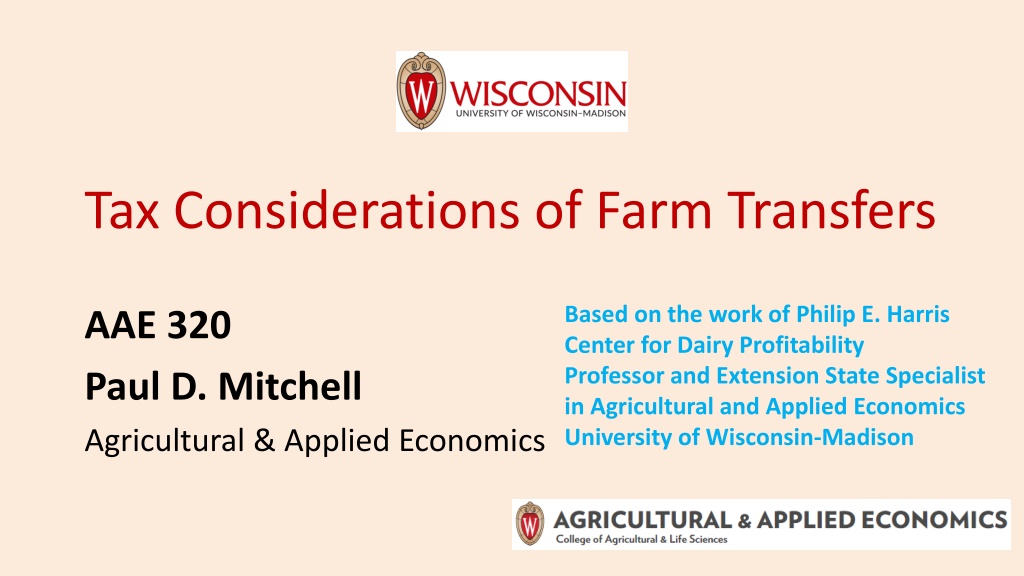

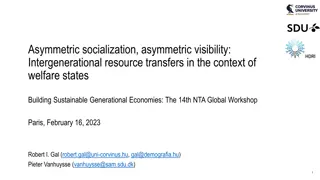

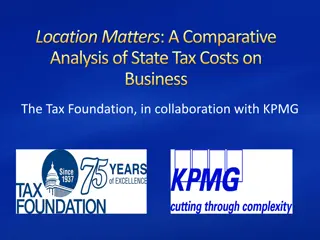
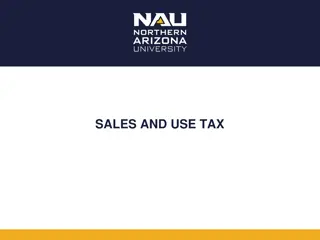

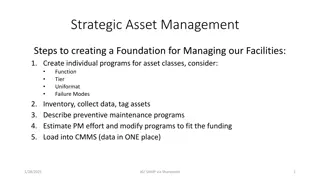
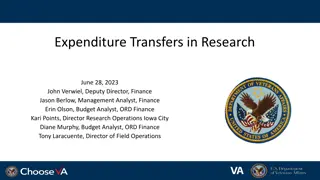

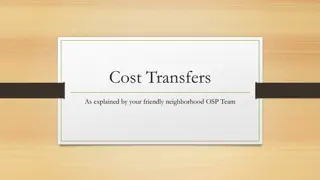
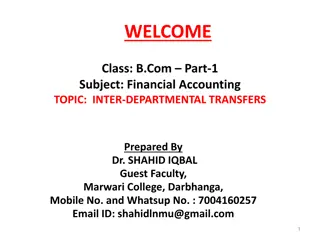
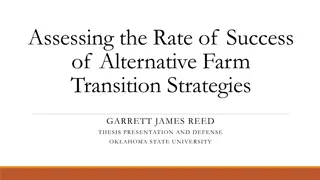


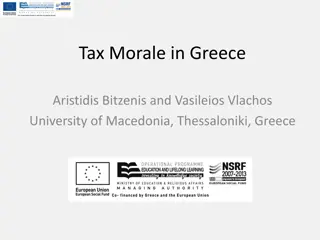
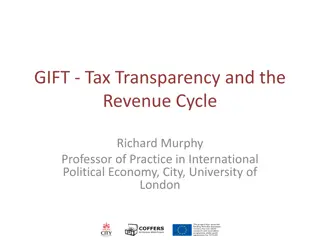

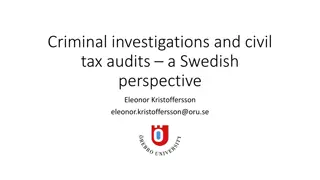

![Town of [Town Name] Real Estate Tax Rates and FY 2024 Budget Summary](/thumb/62211/town-of-town-name-real-estate-tax-rates-and-fy-2024-budget-summary.jpg)

